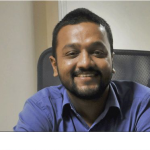How Convergytics started
Randhir Hebbar co-founded Convergytics along with Sanjeev and Santosh. Randhir had an Engineering Degree from Bangalore University and an MBA from HKUST and London Business School along with over 12 years of experience in the Consulting Industry (IT, Retail, Analytics, Digital) before he started Convergytics. He had tried his luck in a couple of start-ups before Convergytics. One in the Medical Device Space (Zeopane) with a German Classmate just after his MBA that did not work out as planned and the other one in the services space had limited success, but could not scale. However, he learnt a lot from the two failures / limited successes. Randhir joined Mu Sigma after his MBA when it was around 200 people and saw it grow up to 2000 people within the 2 years that he worked there. Santosh and Randhir had already worked together for many years in multiple roles at Infosys, Mu Sigma and Dell. Santosh, Sanjeev and Randhir were with Mu Sigma at the same time for over a year and had worked with each other on a few projects.
During early discussions around starting Convergytics, all three founders felt that the industry was moving towards a factory model of churning analytics models and reports by just adding more bodies on projects without focusing on delivering solutions that get consumed and that drive value to the clients. There was also a lot of talk about building solutions in companies, but not enough of a Product / Solution focus due to a short term focus on revenue and profits. There was a strong desire to move away from this model and a mission to convert analytics divisions at Organizations from a Cost Centre to a Profit Centre and this, was Convergytics born.
The fact that the company was formed to bring together / converge the 3 Cs of Creation of Analytics, Consumption of Analytics and Correction of Analytics (Feedback Loop) and the fact that this Convergence was based on the foundation of the Convergence / Fusion of various data sources around the multiple touch-points customers have with a brand led to the name Convergytics as well as the logo with the 3 Crescents converging onto each other.
Market Landscape
The founding team found that the market was filled with lots of companies providing solutions. However, they found that many of the solutions provided in the market were only giving technology solutions but not solving business problems for the prospects. Since it would take time to build a product, they began offering services into the Analytics space. They analysed where their strengths were because they did not want to address a broad market. They tapped into their individual strengths (Sanjeev in CRM, Marketing & Pricing, Santosh in CRM and Randhir in Digital and BI). They chose to target the industries they had worked in the past because they knew the domain and the challenges therein and began approaching the market and a few times even declined enquiries from industries that were not in their focus areas. Randhir says that this was ironical because any startup will go into any projects and then will build the IP based on the revenue that will come in. They however, did not want to get into something for the sake of revenue and deliver something that will not provide value to the customer. The team stuck on to their segments and got the projects and also began building their IP in terms of frameworks and ready-to-market consumption focussed tools / simulators to get a head-start over other competitors.
Segmentation and Sales Outreach
Randhir and team felt that prospects will hesitate to work with them because Convergytics was a new name in the industry. Hence, they chose to start by approaching the people they had worked with in the past and those within their network (alumni, friends, past colleagues and clients). This helped them build the trust. In the early days, they took the list of their targeted companies and leveraged their network to connect to the decision makers. This outreach method gave them lots of active conversations but this was not enough to reach out to a wider audience. After the first few quarters, when they realized that mere network outreach may not be sufficient, they began their cold calling, email outreach focussing on industries where they had the initial traction. With this, they were able to build a structured outreach program and got lot more conversations and deals. They restarted their sales efforts within India a few quarters back and are now looking at newer markets such as UK, Australia and Singapore and are continuing to focus on the US markets in a big way.
First Customer
The first few months involved 100s of calls, 1000s of emails, several brainstorming sessions on how to crack the first big deal and lots of patience as we sat in our small garage office above Randhir’s house and worked several long nights. It wasn’t like there was no work coming forth. Convergytics was able to work on several interesting projects in the initial days, but none of them were converting into a large contract. Eventually, one of the clients decided to give a challenging assignment to test Convergytics and challenged them to work on a Big Data Project and turn around a project in 2 weeks – a project Convergytics originally estimated would take at least 6 weeks. At the time, the team was just the Management Team. So, they rolled their sleeves and got down to work. What made it difficult was that there were 2 other pilot engagements in progress and only Randhir could work on this project. They hired an analyst, bought out his notice period and got cracking on the project using an agile approach to building the solution. The next two weeks were spent on loads of caffeine, 2-3 hours of sleep each day and working thru dozens of data challenges along with long calls with the clients to get regular feedback on intermediate versions of the deliverable. And lo and behold, a day before the deadline, Randhir sent out the final deliverable with the required documentation and then began the wait to hear back from the customer. Luckily for Convergytics, the wait wasn’t too long. client responded with good feedback and within a few weeks signed on the dotted line for a mid-sized engagement that got Convergytics off the ground.
Early Stories & Challenges
Randhir talks about one of the early sales battles. The competition landscape was large Analytics companies compared to Convergytics team of 3 founders and 2 fresher’s. Randhir recollects that the competition, because of its size, could afford to put in 30 people on this PoC. Randhir and team went in with 3-4 people on the project including the Co-Founders. While the other companies were solving the technology challenge and looking at it as a Math problem or multiple individual math problems, Convergytics looked at how customer will use this and delivered a business solution with a simulator that simplified decision making and scenario planning. The end result of the PoC turned out to be a huge surprise for most people including the clients and the competitors to see a new startup take on the big and mighty and come out on top.
Normally, the questions that are asked by an Analytics firm to understand the customers’ needs will be centred around Data and Variables. The Convergytics team brought in a mind-set of a management consultant to understand the customer’s needs. They asked business questions on why the customer was doing this and how will they use it in the future to understand the business impact. This helped them to do a POC and show the customer something that the customer never thought about and hence became very happy with the capability of Convergytics. The typical apprehensions customers had were around the lack of an organization, a large support team and capabilities to scale. Randhir and his team allayed that by taking small assignments that the customer was comfortable in taking the risk and provided value. The other apprehension on the data security aspect of how Convergytics worked. This was allayed by addressing the question upfront and offering models of working within the client networks as well as putting getting Security Compliance Certifications such as ISO-27001.
Next few months
Randhir recalls that the first few projects were taken at cost to enable two things 1) To bring in the revenue 2) To build the IP in the area they wanted to and 3) Build success stories and their portfolio. They made sure that the first few customers were kept very happy and these case studies got them their next set of new customers. Randhir says that the deliverables from their projects were significantly different from the ones that the other analytics companies were delivering. This got them to sharpen their IP and the competitive advantage.
One thing they could have done better
Randhir says that they were conservative on the investments. They did not have anyone in the US for a long time. Randhir says that they also did not focus much on sales as they decided that one of the co-founders will handle sales and the other two will set up teams and will handle existing accounts respectively. Randhir says that this did help setup the base for the company, but there wasn’t enough of a push on new business. However, they figured out that it is just not enough to invest in an ace team and it was equally important to sharpen the outreach. They found out that they could have sustained and have grown the team much better by focusing on bringing in more deals. This, Randhir feels would have ensured that the team got diversity of work which would have been a great way to build, groom, mentor and to motivate the team .
Randhir says that they could have also hired someone to handle delivery which would have freed all of them to go out and sell as no one can sell better than a founder in the early days. Alternately, they could have also got a professional from the industry to go out and sell. These are some of the steps that they have taken on recently, but they feel that they could have been much bigger if they had done it in the past.
Randhir’s Advice to early stage entrepreneurs on Sales
Don’t be too conservative. Go all out not only from an effort perspective but also from a strategy perspective. Look at the options, channel acquisitions and do it with a measurement focussed approach. Don’t just be happy by blasting emails, making the calls but measure the effectiveness and quickly fine-tune for betterment. They meet at least once a month to find out what works and what does not and will make the changes to do better in the subsequent months. The startup ecosystem has evolved and there are more mentors and advisors who are willing to help start-ups. Explore all of that options.
Convergytics today
They have 35 people today and work with over 20+ companies across the globe including several Fortune 500 Companies. They recently won the award of “Fastest growing Analytics Startup in Asia” by UK Based Global Brands Magazine (GBM). They are still bootstrapped and have been profitable throughout and are now exploring getting external funding to fast-track their growth






